Yu Lu
WATCH: World-aware Allied Trajectory and pose reconstruction for Camera and Human
Sep 04, 2025Abstract:Global human motion reconstruction from in-the-wild monocular videos is increasingly demanded across VR, graphics, and robotics applications, yet requires accurate mapping of human poses from camera to world coordinates-a task challenged by depth ambiguity, motion ambiguity, and the entanglement between camera and human movements. While human-motion-centric approaches excel in preserving motion details and physical plausibility, they suffer from two critical limitations: insufficient exploitation of camera orientation information and ineffective integration of camera translation cues. We present WATCH (World-aware Allied Trajectory and pose reconstruction for Camera and Human), a unified framework addressing both challenges. Our approach introduces an analytical heading angle decomposition technique that offers superior efficiency and extensibility compared to existing geometric methods. Additionally, we design a camera trajectory integration mechanism inspired by world models, providing an effective pathway for leveraging camera translation information beyond naive hard-decoding approaches. Through experiments on in-the-wild benchmarks, WATCH achieves state-of-the-art performance in end-to-end trajectory reconstruction. Our work demonstrates the effectiveness of jointly modeling camera-human motion relationships and offers new insights for addressing the long-standing challenge of camera translation integration in global human motion reconstruction. The code will be available publicly.
DuPO: Enabling Reliable LLM Self-Verification via Dual Preference Optimization
Aug 20, 2025Abstract:We present DuPO, a dual learning-based preference optimization framework that generates annotation-free feedback via a generalized duality. DuPO addresses two key limitations: Reinforcement Learning with Verifiable Rewards (RLVR)'s reliance on costly labels and applicability restricted to verifiable tasks, and traditional dual learning's restriction to strictly dual task pairs (e.g., translation and back-translation). Specifically, DuPO decomposes a primal task's input into known and unknown components, then constructs its dual task to reconstruct the unknown part using the primal output and known information (e.g., reversing math solutions to recover hidden variables), broadening applicability to non-invertible tasks. The quality of this reconstruction serves as a self-supervised reward to optimize the primal task, synergizing with LLMs' ability to instantiate both tasks via a single model. Empirically, DuPO achieves substantial gains across diverse tasks: it enhances the average translation quality by 2.13 COMET over 756 directions, boosts the mathematical reasoning accuracy by an average of 6.4 points on three challenge benchmarks, and enhances performance by 9.3 points as an inference-time reranker (trading computation for accuracy). These results position DuPO as a scalable, general, and annotation-free paradigm for LLM optimization.
Seed LiveInterpret 2.0: End-to-end Simultaneous Speech-to-speech Translation with Your Voice
Jul 24, 2025



Abstract:Simultaneous Interpretation (SI) represents one of the most daunting frontiers in the translation industry, with product-level automatic systems long plagued by intractable challenges: subpar transcription and translation quality, lack of real-time speech generation, multi-speaker confusion, and translated speech inflation, especially in long-form discourses. In this study, we introduce Seed-LiveInterpret 2.0, an end-to-end SI model that delivers high-fidelity, ultra-low-latency speech-to-speech generation with voice cloning capabilities. As a fully operational product-level solution, Seed-LiveInterpret 2.0 tackles these challenges head-on through our novel duplex speech-to-speech understanding-generating framework. Experimental results demonstrate that through large-scale pretraining and reinforcement learning, the model achieves a significantly better balance between translation accuracy and latency, validated by human interpreters to exceed 70% correctness in complex scenarios. Notably, Seed-LiveInterpret 2.0 outperforms commercial SI solutions by significant margins in translation quality, while slashing the average latency of cloned speech from nearly 10 seconds to a near-real-time 3 seconds, which is around a near 70% reduction that drastically enhances practical usability.
In-Context Edit: Enabling Instructional Image Editing with In-Context Generation in Large Scale Diffusion Transformer
Apr 29, 2025Abstract:Instruction-based image editing enables robust image modification via natural language prompts, yet current methods face a precision-efficiency tradeoff. Fine-tuning methods demand significant computational resources and large datasets, while training-free techniques struggle with instruction comprehension and edit quality. We resolve this dilemma by leveraging large-scale Diffusion Transformer (DiT)' enhanced generation capacity and native contextual awareness. Our solution introduces three contributions: (1) an in-context editing framework for zero-shot instruction compliance using in-context prompting, avoiding structural changes; (2) a LoRA-MoE hybrid tuning strategy that enhances flexibility with efficient adaptation and dynamic expert routing, without extensive retraining; and (3) an early filter inference-time scaling method using vision-language models (VLMs) to select better initial noise early, improving edit quality. Extensive evaluations demonstrate our method's superiority: it outperforms state-of-the-art approaches while requiring only 0.5% training data and 1% trainable parameters compared to conventional baselines. This work establishes a new paradigm that enables high-precision yet efficient instruction-guided editing. Codes and demos can be found in https://river-zhang.github.io/ICEdit-gh-pages/.
Do PhD-level LLMs Truly Grasp Elementary Addition? Probing Rule Learning vs. Memorization in Large Language Models
Apr 07, 2025Abstract:Despite high benchmark scores, Large Language Models (LLMs) often fail simple problem, raising a critical question: Do LLMs learn mathematical principles or merely memorize patterns? Rather than designing increasingly complex benchmarks like recent works, we investigate this using elementary two-integer addition ($0$ to $2^{64}$), probing two core properties: commutativity ($A+B=B+A$) and compositional generalization (via isomorphic symbolic mappings, e.g., $7 \rightarrow y$). While state-of-the-art LLMs achieve 73.8-99.8\% accuracy on numerical addition, performance collapses to $\leq$7.5\% under symbolic mapping, indicating failure to generalize learned rules. Non-monotonic performance scaling with digit count and frequent commutativity violations (over 1,700 cases of $A+B \neq B+A$) further support this. Explicitly providing addition rules degrades performance by 81.2\% on average, while self-explanation maintains baseline accuracy, suggesting LLM arithmetic processing is misaligned with human-defined principles. Our findings indicate current LLMs rely on memory pattern over genuine rule learning, highlighting architectural limitations and the need for new approaches to achieve true mathematical reasoning.
HarmonySet: A Comprehensive Dataset for Understanding Video-Music Semantic Alignment and Temporal Synchronization
Mar 04, 2025


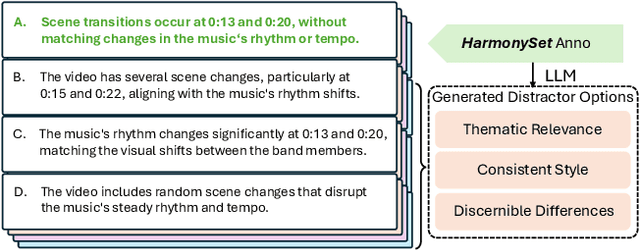
Abstract:This paper introduces HarmonySet, a comprehensive dataset designed to advance video-music understanding. HarmonySet consists of 48,328 diverse video-music pairs, annotated with detailed information on rhythmic synchronization, emotional alignment, thematic coherence, and cultural relevance. We propose a multi-step human-machine collaborative framework for efficient annotation, combining human insights with machine-generated descriptions to identify key transitions and assess alignment across multiple dimensions. Additionally, we introduce a novel evaluation framework with tasks and metrics to assess the multi-dimensional alignment of video and music, including rhythm, emotion, theme, and cultural context. Our extensive experiments demonstrate that HarmonySet, along with the proposed evaluation framework, significantly improves the ability of multimodal models to capture and analyze the intricate relationships between video and music.
UBER: Uncertainty-Based Evolution with Large Language Models for Automatic Heuristic Design
Dec 30, 2024



Abstract:NP-hard problem-solving traditionally relies on heuristics, but manually crafting effective heuristics for complex problems remains challenging. While recent work like FunSearch has demonstrated that large language models (LLMs) can be leveraged for heuristic design in evolutionary algorithm (EA) frameworks, their potential is not fully realized due to its deficiency in exploitation and exploration. We present UBER (Uncertainty-Based Evolution for Refinement), a method that enhances LLM+EA methods for automatic heuristic design by integrating uncertainty on top of the FunSearch framework. UBER introduces two key innovations: an Uncertainty-Inclusive Evolution Process (UIEP) for adaptive exploration-exploitation balance, and a principled Uncertainty-Inclusive Island Reset (UIIS) strategy for maintaining population diversity. Through extensive experiments on challenging NP-complete problems, UBER demonstrates significant improvements over FunSearch. Our work provides a new direction for the synergy of LLMs and EA, advancing the field of automatic heuristic design.
Energy-Efficient RIS-Aided Cell-Free Massive MIMO Systems: Application, Opportunities, and Challenges
Dec 23, 2024



Abstract:Reconfigurable intelligent surfaces (RIS)-assisted cell-free massive multiple-input multiple-output (CF mMIMO) systems have emerged as a promising technology for sixth-generation communication systems. These systems capitalize on RIS to minimize power consumption, thereby achieving consistent performance and enhancing communication quality through the establishment and shaping of auxiliary signal propagation pathways between access points (APs) and users. However, integrating RIS into existing CF mMIMO infrastructures presents several technical challenges. This study delves into the signal transmission scheme and deployment architecture of RIS-aided CF mMIMO systems, addressing inherent challenges such as interference induced by RIS and the increased complexity in beam alignment. Furthermore, we address the complexities arising from the joint optimization of the reflection phase of RIS and beamforming technology at the APs, intending to fully exploit the reflection capabilities of RISs and beamforming technology to maximize the energy efficiency (EE) of the system. To overcome these challenges, we propose cooperation communication to suppress RIS-induced interference, beam tracking, and joint optimization to improve system EE. We also present specific examples of cooperative communication under the constraint of electromagnetic interference and the beam tracking of a mobile system. Additionally, we emphasize important research directions for RIS-aided CF mMIMO systems, aiming to inspire future investigations.
Push the Limit of Multi-modal Emotion Recognition by Prompting LLMs with Receptive-Field-Aware Attention Weighting
Nov 26, 2024



Abstract:Understanding the emotions in a dialogue usually requires external knowledge to accurately understand the contents. As the LLMs become more and more powerful, we do not want to settle on the limited ability of the pre-trained language model. However, the LLMs either can only process text modality or are too expensive to process the multimedia information. We aim to utilize both the power of LLMs and the supplementary features from the multimedia modalities. In this paper, we present a framework, Lantern, that can improve the performance of a certain vanilla model by prompting large language models with receptive-field-aware attention weighting. This framework trained a multi-task vanilla model to produce probabilities of emotion classes and dimension scores. These predictions are fed into the LLMs as references to adjust the predicted probabilities of each emotion class with its external knowledge and contextual understanding. We slice the dialogue into different receptive fields, and each sample is included in exactly t receptive fields. Finally, the predictions of LLMs are merged with a receptive-field-aware attention-driven weighting module. In the experiments, vanilla models CORECT and SDT are deployed in Lantern with GPT-4 or Llama-3.1-405B. The experiments in IEMOCAP with 4-way and 6-way settings demonstrated that the Lantern can significantly improve the performance of current vanilla models by up to 1.23% and 1.80%.
MME-Finance: A Multimodal Finance Benchmark for Expert-level Understanding and Reasoning
Nov 05, 2024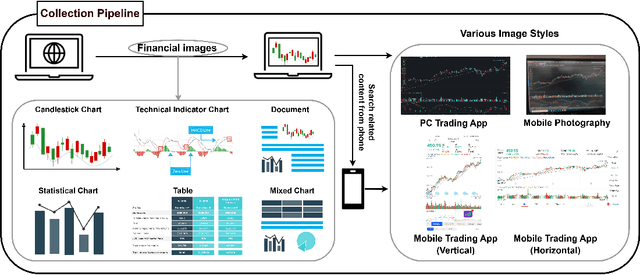
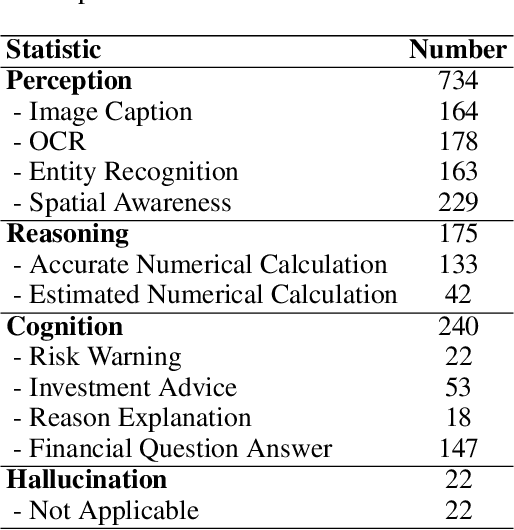
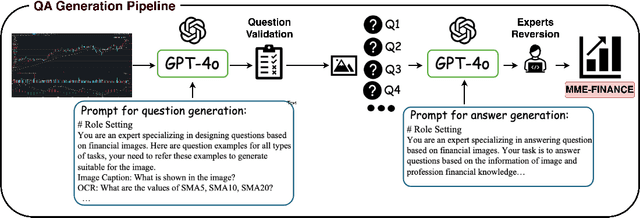
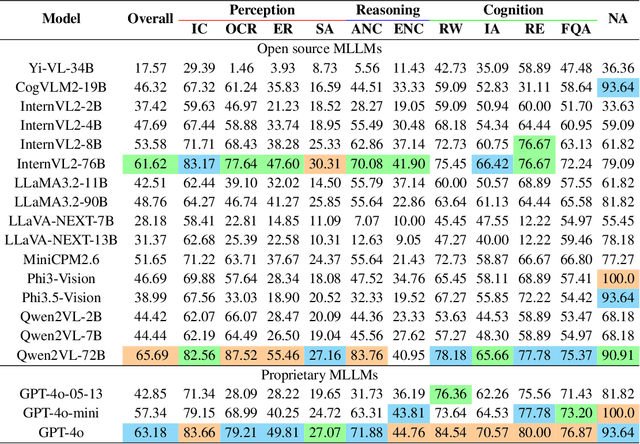
Abstract:In recent years, multimodal benchmarks for general domains have guided the rapid development of multimodal models on general tasks. However, the financial field has its peculiarities. It features unique graphical images (e.g., candlestick charts, technical indicator charts) and possesses a wealth of specialized financial knowledge (e.g., futures, turnover rate). Therefore, benchmarks from general fields often fail to measure the performance of multimodal models in the financial domain, and thus cannot effectively guide the rapid development of large financial models. To promote the development of large financial multimodal models, we propose MME-Finance, an bilingual open-ended and practical usage-oriented Visual Question Answering (VQA) benchmark. The characteristics of our benchmark are finance and expertise, which include constructing charts that reflect the actual usage needs of users (e.g., computer screenshots and mobile photography), creating questions according to the preferences in financial domain inquiries, and annotating questions by experts with 10+ years of experience in the financial industry. Additionally, we have developed a custom-designed financial evaluation system in which visual information is first introduced in the multi-modal evaluation process. Extensive experimental evaluations of 19 mainstream MLLMs are conducted to test their perception, reasoning, and cognition capabilities. The results indicate that models performing well on general benchmarks cannot do well on MME-Finance; for instance, the top-performing open-source and closed-source models obtain 65.69 (Qwen2VL-72B) and 63.18 (GPT-4o), respectively. Their performance is particularly poor in categories most relevant to finance, such as candlestick charts and technical indicator charts. In addition, we propose a Chinese version, which helps compare performance of MLLMs under a Chinese context.
 Add to Chrome
Add to Chrome Add to Firefox
Add to Firefox Add to Edge
Add to Edge